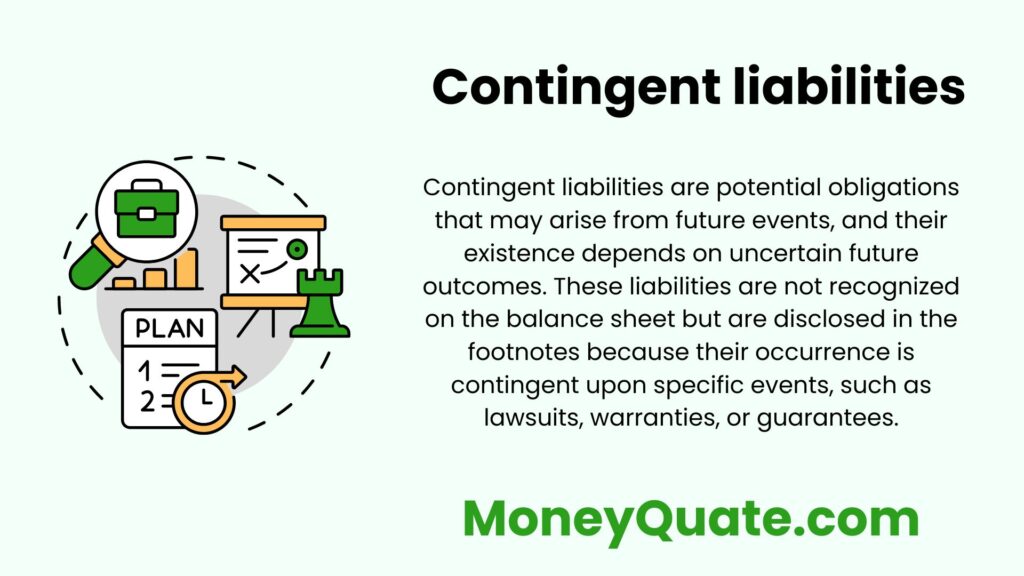Contingent liabilities are liabilities that are not recognized on the balance sheet because they depend on uncertain future events. These events may or may not occur, and their outcome determines whether a liability will be incurred.

Contents
Understanding Contingent Liabilities
Nature of Contingencies
Contingent liabilities arise from situations where an obligation is possible, but not probable or cannot be reliably measured. These obligations are contingent upon future events or outcomes.
Recognition Criteria
Contingent liabilities are recognized in the financial statements if:
- It is probable that an outflow of resources embodying economic benefits will be required to settle the obligation.
- The amount of the obligation can be reliably estimated.
Types of Contingencies
- Pending litigation or legal claims against the company.
- Product warranties and guarantees.
- Environmental liabilities.
- Tax disputes.
- Pending government investigations.
Disclosure in Financial Statements
Contingent liabilities are disclosed in the financial statements’ notes if the possibility of loss is reasonably possible and the amount can be estimated.
If the possibility of loss is remote, no disclosure is required.
Measurement and Estimation
The amount of contingent liabilities is typically estimated based on available information, including legal advice, historical experience, and expert opinions.
Impact on Financial Statements
Contingent liabilities affect the company’s financial position and potential future cash outflows. Disclosure of significant contingencies provides transparency to stakeholders.
Legal Contingencies
Legal contingencies arise from pending or threatened litigation, claims, or assessments against the company. The likelihood of loss and the estimated amount are evaluated to determine recognition and disclosure.
Example of Contingent Liabilities
Consider a company facing a lawsuit filed by a former employee for wrongful termination. The lawsuit seeks damages of $500,000. The company’s legal counsel assesses the case and determines that there’s a 60% chance of losing the lawsuit.
Recognition: Since it’s probable (60% likelihood) that the company will lose the lawsuit and the amount can be reliably estimated ($500,000), a contingent liability of $300,000 ($500,000 x 60%) is recognized.
Disclosure: The contingent liability of $300,000 is disclosed in the financial statements’ notes, providing transparency to investors and creditors about the potential legal obligation.
Importance of Contingent Liabilities
Transparency: Disclosure of contingent liabilities enhances transparency in financial reporting, allowing stakeholders to assess the company’s potential risks and exposures.
Risk Management: Identifying and evaluating contingent liabilities helps management assess potential risks and implement strategies to mitigate adverse outcomes.
Investor Confidence: Transparent disclosure of significant contingencies fosters investor confidence by providing insights into the company’s potential future liabilities and financial health.
Conclusion
Contingent liabilities represent potential obligations that may arise from uncertain future events. Proper recognition and disclosure of these liabilities are essential for transparent financial reporting and effective risk management. Understanding the nature and impact of contingent liabilities enables companies to provide stakeholders with reliable information for decision-making.
1 thought on “Unlocking Hidden Risks: The Role of Contingent Liabilities”